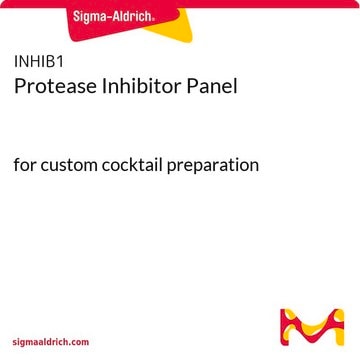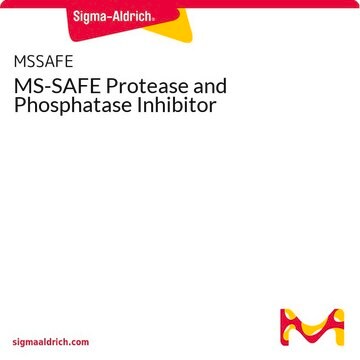P1860
Protease Inhibitor Cocktail
DMSO solution, for the inhibition of serine, cysteine, aspartic proteases and aminopeptidases, for use in tissue culture media, DMSO solution
Synonym(s):
Protease Inhibitor Solution, protease inhibitor
About This Item
Recommended Products
product name
Protease Inhibitor Cocktail, for use in tissue culture media, DMSO solution
Quality Level
form
DMSO solution
shipped in
dry ice
storage temp.
−20°C
Looking for similar products? Visit Product Comparison Guide
General description
A431, CHO, COS, HepG2, and HeLa adherent cell lines
Jurkat and HL-60 cell lines grown in suspension
Specificity
Application
- as a supplement in supernatants and lysates for ex vivo infection experiments using human precision-cut lung slices (PCLS)
- to inhibit proteolysis by trypsin to prove that proteolysis is responsible for restoration of catalysis of corona-inhibited nanozymes
- in trypsin solution for trypsin-inhibited studies
- as a component in radioimmunoprecipitation assay (RIPA) buffer to lyse leukocytes for western blot
Biochem/physiol Actions
Features and Benefits
- Broad specificity
- Non-toxic: After 48 hours exposure, the product is non-toxic to adherent cell lines A431, CHO, COS, HepG2 and HeLa; and to Jurkat and HL-60 cell lines grown in suspension.
- Contains no metal chelators: Ensures compatibility with downstream applications
- Convenient packaging: 1 mL in glass bottle
- Easy to use: Use at a dilution of 1:200 or more in tissue culture media to prevent proteolytic degradation of secreted proteins.
Components
Bestatin
E-64
Leupeptin
Pepstatin A
Caution
Quantity
Physical form
Other Notes
related product
Storage Class Code
10 - Combustible liquids
WGK
WGK 1
Flash Point(F)
188.6 °F
Flash Point(C)
87 °C
Certificates of Analysis (COA)
Search for Certificates of Analysis (COA) by entering the products Lot/Batch Number. Lot and Batch Numbers can be found on a product’s label following the words ‘Lot’ or ‘Batch’.
Already Own This Product?
Find documentation for the products that you have recently purchased in the Document Library.
Customers Also Viewed
Articles
While aprotinin and bovine pancreatic trypsin inhibitor (BPTI) are the same protein sequence, the term aprotinin is typically used when describing the protein derived from bovine lung.
Related Content
Select different protease inhibitor types based on your needs to prevent protein degradation during isolation and characterization and safeguard proteins in sample prep.
Select different protease inhibitor types based on your needs to prevent protein degradation during isolation and characterization and safeguard proteins in sample prep.
Select different protease inhibitor types based on your needs to prevent protein degradation during isolation and characterization and safeguard proteins in sample prep.
Select different protease inhibitor types based on your needs to prevent protein degradation during isolation and characterization and safeguard proteins in sample prep.
Our team of scientists has experience in all areas of research including Life Science, Material Science, Chemical Synthesis, Chromatography, Analytical and many others.
Contact Technical Service













